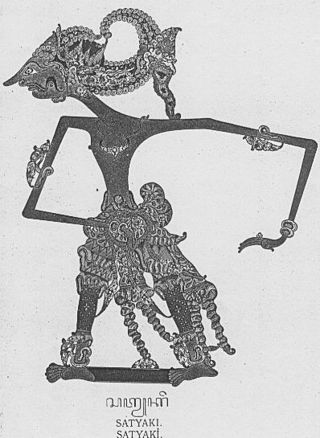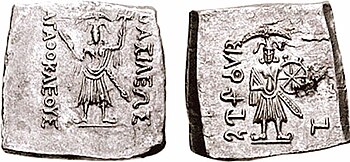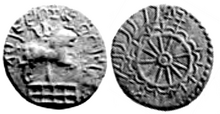
Balarama is a Hindu god. The elder brother of Vāsudeva-Krishna he is described in the Bhagavata Purana as the highest form of divinity that expanded into Vishnu and creation. He is particularly significant in the Jagannath tradition, as one of the triad deities. He is also known as Haladhara, Halayudha, Baladeva, Balabhadra, and Sankarshana.

According to Hindu scriptures, Vasudeva, also called Anakadundubhi, is the father of the Hindu deities Krishna, Balarama, and Subhadra. He was a king of the Vrishnis, and a Yadava prince. The son of the Yadava king Shurasena, he was also the second cousin of Nanda, the foster-father of Krishna. His sister Kunti was married to Pandu.

Subhadra is a figure in Hindu mythology, known for being the younger sister of gods Krishna and Balarama. According to Hindu scriptures, she was a princess from the Yadava clan, who married Arjuna—one of the Pandava brothers—and had a son named Abhimanyu.

Pradyumnatransl. 'the eminently mighty one' is the eldest son of the Hindu deities Krishna and his chief consort, Rukmini. He is considered to be one of the four vyuha avatars of Vishnu. According to the Bhagavata Purana, Pradyumna was the reincarnation of Kamadeva, the god of love. The Mahabharata states that Pradyumna was a portion of Sanat Kumara.

The kingdom of Surasena was an ancient Indian region corresponding to the present-day Braj region in Uttar Pradesh, with Mathura as its capital city. According to the Buddhist text Anguttara Nikaya, Surasena was one of the sixteen Mahajanapadas in the 6th century BCE. Also, it is mentioned in the Hindu epic poem Ramayana. The ancient Greek writers refer to the Sourasenoi and its cities, Methora and Cleisobra.

Yuyudhana, better known as Satyaki, was a powerful Yadava chieftain of Narayani Sena, belonging to the Vrishni clan to which Krishna also belonged. According to the Puranas, he was the grandson of Shini of the Vrishni clan, and son of Satyaka, after whom he was named. A valiant warrior, Satyaki was devoted to Krishna and was a student of Arjuna.

Avanti was an ancient Indian Mahajanapada, roughly corresponding to the present-day Malwa region. According to the Buddhist texts, the Anguttara Nikaya, Avanti was one of the solasa mahajanapadas of the 6th century BCE. The janapada was divided into two parts by the Vindhyas, the northern part had its capital at Ujjayini and the southern part had its centre at Mahishmati.
Kritavarma is a Vrishni Yadava warrior in Hinduism. He appears as a minor character in the Mahabharata, fighting in the Kurukshetra war for the Kauravas.. Kritvarma was the commander of the Narayani sena consisting of gopas.
In the Mahabharata epic, the Heheya Kingdom is one of the kingdoms ruled by Chandravanshi (Yadava) kings in central and western India. It was ruled by Kartavirya Arjuna, who defeated Ravana. Its capital was Mahishmati on the banks of river Narmada in present-day Madhya Pradesh. Talajangha was an allied kingdom to the east of Heheya. They conquered many other kingdoms of India until enmity with the warrior Bhargavas resulted in their demise. Parasurama was the Bhargava leader who ended the kingdom.
Anarta is a Vedic period kingdom of ancient India described in the Mahabharata, roughly forming the northern Gujarat state of India. It was founded by a grandson of Vaivasvata, inter alia the father of the present Manu and of Yama, named Anarta. He built a fortress at Kusasthali (Dvaraka), which was later flooded by Varuna. The place remained then for some time as a forest land, before Krishna and the Yadavas went there and built Dvaraka. It was then ruled by Yadavas after they fled from Mathura of Surasena Kingdom, due to the attacks of Jarasandha, the king of Magadha. The Yadava chiefs like Vasudeva Krishna, Bala Rama, Kritavarma and Satyaki, ruled this kingdom under their king Ugrasena. In Mahabharata, Dwaraka is considered as a capital city of Anarta Kingdom. But some other ancient texts like Mahabhagavata, mentions Dwaraka and Anarta as two independent kingdoms. As per the Purana viz. Bhagavata Purana, Bala Rama's wife Revati was from this kingdom.

The Abhira kingdom in the Mahabharata is either of two kingdoms near the Sarasvati river. It was dominated by the Abhiras, sometimes referred to as Surabhira also, combining both Sura and Abhira kingdoms. Modern day Abhira territory lies within Northern areas of Gujarat and Southern Rajasthan, India.
In the Hindu epic Mahabharata, Krishna is the son of the Yaduvamsha chief Vasudeva and his wife Devaki. He is also widely known by his epithet, Vāsudeva.

The Vrishnis were an ancient Vedic Indian clan who were believed to be the descendants of Vrishni. It is believed that Vrishni was the son of Satvata, a descendant of Yadu, the son of Yayati. He had two wives, Gandhari and Madri, not to be confused with Gandhari and Madri from the Mahabharata. He has a son named Devamidhusha by his wife Madri. Vasudeva, the father of Krishna was the grandson of Devamidhusha. According to the Puranas, the Vrishnis were residents of Dvaraka.
Dantavakra is the king of Karusha in Hinduism. Dantavakra is the third and last birth of Vishnu's gatekeeper, Vijaya, while his brother Jaya is Shishupala.
Madhu Forest or Madhuvana was a dense forest in ancient northern India, west of Yamuna.
The Abhira people were a legendary people mentioned in ancient Indian epics and scriptures as early as the Vedas. A historical people of the same name are mentioned in the Periplus of the Erythraean Sea. The Mahabharata describes them as living near the seashore and on the bank of the Sarasvati River, near Somnath in Gujarat and in the Matsya region also.

Samba was a son of the Hindu Krishna and his second consort, Jambavati. His foolish prank brought an end to the Yadu dynasty.
In Hindu texts, the Puru and Yadu Dynasties are the descendants of legendary King Pururavas who was a famous Hindu ruler in the Treta Yuga. Pururavas was the son of Ila and Budha. Some of the dynasties' important members were Yayati, Yadu, King Puru, Turvasu, Druhyu and Anu. According to Hindu mythology, Yayāti was one of the ancestors of Pandavas and the Yaduvamsha.

The Vrishni heroes, also referred to as Pancha-viras, are a group of five legendary, deified heroes who are found in the literature and archaeological sites of ancient India. Their earliest worship is attestable in the clan of the Vrishnis near Mathura by 4th-century BCE. Legends are associated with these deified heroes, some of which may be based on real, historical heroes of the Vrishni clan. Their early worship has been variously described as cross-sectarian, much like the cult of the Yakshas, related to the early Bhagavata tradition of Hinduism, and with possible links to Jainism as well. They and their legends – particularly of Krishna and Balarama – have been an important part of the Vaishnava tradition of Hinduism.

The Bhoja tribes were a collection of semi-Aryan ancient tribes, located in India during the Late Vedic Period. They are described as being an offshoot of the Yadava tribe in the Indian epic of Mahabharata. They were a branch of the Andhaka clan, who were in turn descendants of the Satvata clan descended from King Yadu. The Bhojas were sub-divided into eighteen branches and ruled from their capital at Mrittikavati, on the banks of the Parnasa river in Central India.













